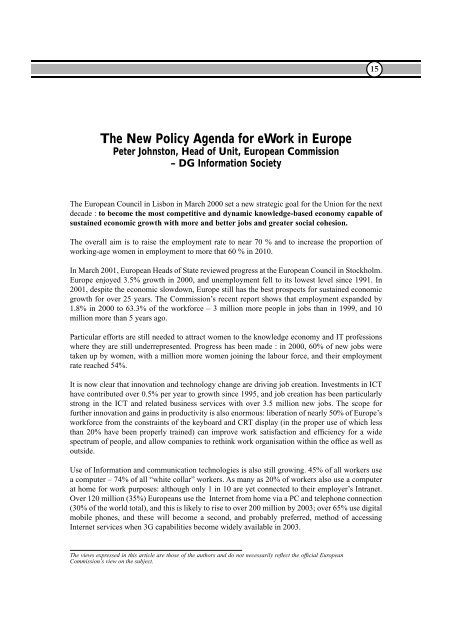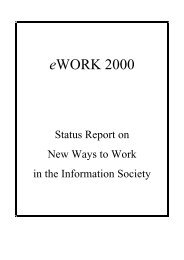Proceedings of 8th European Assembly on telework (Telework2001)
Proceedings of 8th European Assembly on telework (Telework2001)
Proceedings of 8th European Assembly on telework (Telework2001)
You also want an ePaper? Increase the reach of your titles
YUMPU automatically turns print PDFs into web optimized ePapers that Google loves.
15The New Policy Agenda for eWork in EuropePeter Johnst<strong>on</strong>, Head <str<strong>on</strong>g>of</str<strong>on</strong>g> Unit, <str<strong>on</strong>g>European</str<strong>on</strong>g> Commissi<strong>on</strong>– DG Informati<strong>on</strong> SocietyThe <str<strong>on</strong>g>European</str<strong>on</strong>g> Council in Lisb<strong>on</strong> in March 2000 set a new strategic goal for the Uni<strong>on</strong> for the nextdecade : to become the most competitive and dynamic knowledge-based ec<strong>on</strong>omy capable <str<strong>on</strong>g>of</str<strong>on</strong>g>sustained ec<strong>on</strong>omic growth with more and better jobs and greater social cohesi<strong>on</strong>.The overall aim is to raise the employment rate to near 70 % and to increase the proporti<strong>on</strong> <str<strong>on</strong>g>of</str<strong>on</strong>g>working-age women in employment to more that 60 % in 2010.In March 2001, <str<strong>on</strong>g>European</str<strong>on</strong>g> Heads <str<strong>on</strong>g>of</str<strong>on</strong>g> State reviewed progress at the <str<strong>on</strong>g>European</str<strong>on</strong>g> Council in Stockholm.Europe enjoyed 3.5% growth in 2000, and unemployment fell to its lowest level since 1991. In2001, despite the ec<strong>on</strong>omic slowdown, Europe still has the best prospects for sustained ec<strong>on</strong>omicgrowth for over 25 years. The Commissi<strong>on</strong>’s recent report shows that employment expanded by1.8% in 2000 to 63.3% <str<strong>on</strong>g>of</str<strong>on</strong>g> the workforce – 3 milli<strong>on</strong> more people in jobs than in 1999, and 10milli<strong>on</strong> more than 5 years ago.Particular efforts are still needed to attract women to the knowledge ec<strong>on</strong>omy and IT pr<str<strong>on</strong>g>of</str<strong>on</strong>g>essi<strong>on</strong>swhere they are still underrepresented. Progress has been made : in 2000, 60% <str<strong>on</strong>g>of</str<strong>on</strong>g> new jobs weretaken up by women, with a milli<strong>on</strong> more women joining the labour force, and their employmentrate reached 54%.It is now clear that innovati<strong>on</strong> and technology change are driving job creati<strong>on</strong>. Investments in ICThave c<strong>on</strong>tributed over 0.5% per year to growth since 1995, and job creati<strong>on</strong> has been particularlystr<strong>on</strong>g in the ICT and related business services with over 3.5 milli<strong>on</strong> new jobs. The scope forfurther innovati<strong>on</strong> and gains in productivity is also enormous: liberati<strong>on</strong> <str<strong>on</strong>g>of</str<strong>on</strong>g> nearly 50% <str<strong>on</strong>g>of</str<strong>on</strong>g> Europe’sworkforce from the c<strong>on</strong>straints <str<strong>on</strong>g>of</str<strong>on</strong>g> the keyboard and CRT display (in the proper use <str<strong>on</strong>g>of</str<strong>on</strong>g> which lessthan 20% have been properly trained) can improve work satisfacti<strong>on</strong> and efficiency for a widespectrum <str<strong>on</strong>g>of</str<strong>on</strong>g> people, and allow companies to rethink work organisati<strong>on</strong> within the <str<strong>on</strong>g>of</str<strong>on</strong>g>fice as well asoutside.Use <str<strong>on</strong>g>of</str<strong>on</strong>g> Informati<strong>on</strong> and communicati<strong>on</strong> technologies is also still growing. 45% <str<strong>on</strong>g>of</str<strong>on</strong>g> all workers usea computer – 74% <str<strong>on</strong>g>of</str<strong>on</strong>g> all “white collar” workers. As many as 20% <str<strong>on</strong>g>of</str<strong>on</strong>g> workers also use a computerat home for work purposes: although <strong>on</strong>ly 1 in 10 are yet c<strong>on</strong>nected to their employer’s Intranet.Over 120 milli<strong>on</strong> (35%) <str<strong>on</strong>g>European</str<strong>on</strong>g>s use the Internet from home via a PC and teleph<strong>on</strong>e c<strong>on</strong>necti<strong>on</strong>(30% <str<strong>on</strong>g>of</str<strong>on</strong>g> the world total), and this is likely to rise to over 200 milli<strong>on</strong> by 2003; over 65% use digitalmobile ph<strong>on</strong>es, and these will become a sec<strong>on</strong>d, and probably preferred, method <str<strong>on</strong>g>of</str<strong>on</strong>g> accessingInternet services when 3G capabilities become widely available in 2003.The views expressed in this article are those <str<strong>on</strong>g>of</str<strong>on</strong>g> the authors and do not necessarily refl ect the <str<strong>on</strong>g>of</str<strong>on</strong>g>fi cial <str<strong>on</strong>g>European</str<strong>on</strong>g>Commissi<strong>on</strong>’s view <strong>on</strong> the subject.








